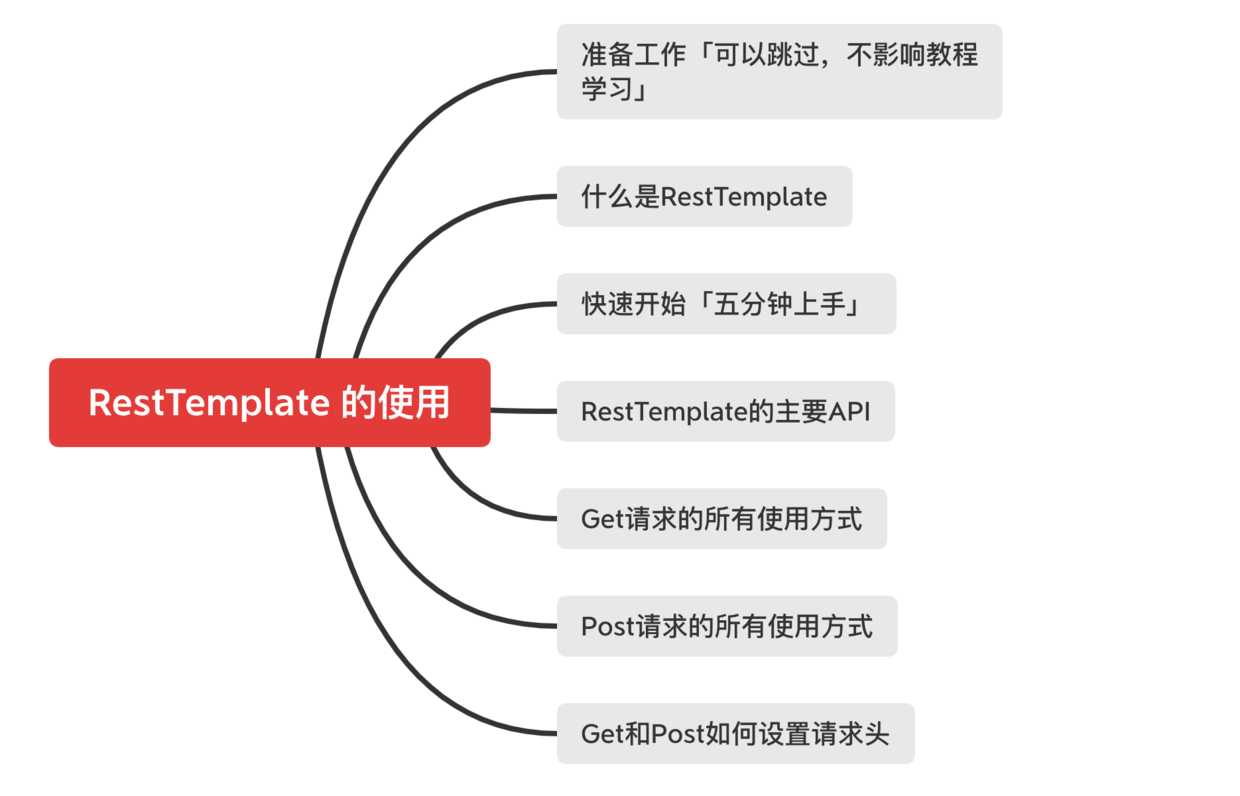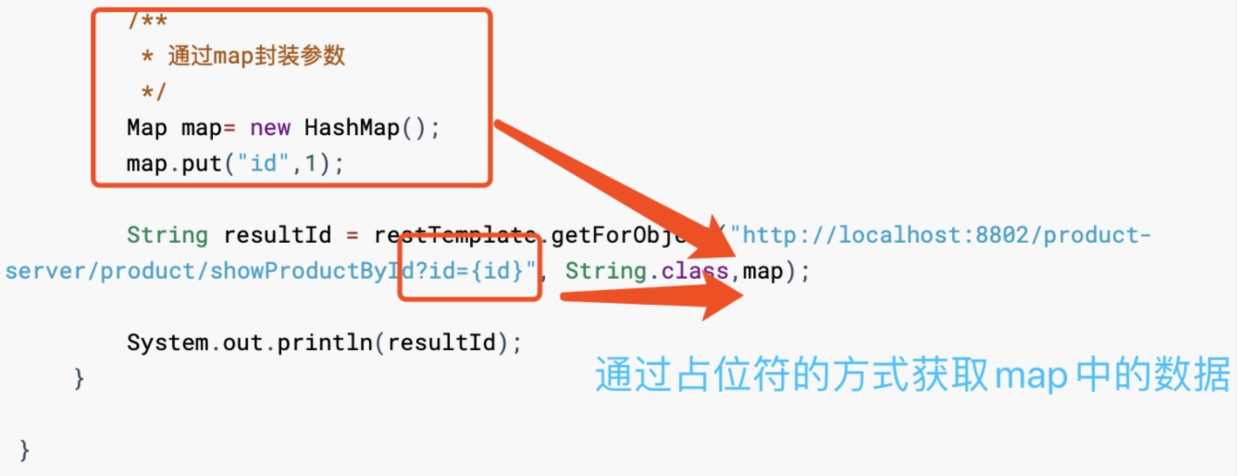标签:print 使用指南 dir 操作 pts 一起学 文件上传 win64 模板类

有天上飞的概念,就要有落地的实现
概念十遍不如代码一遍,朋友,希望你把文中所有的代码案例都敲一遍
先赞后看,养成习惯
SpringBoot 图文教程系列文章目录
问个问题:通过Java代码怎么发送Http请求,请求另一个Java程序的Controller方法呢?

好像真的有点触及到知识盲区了呦
在以前的代码中,Java程序都是被请求的一方,发送请求的要么是Ajax,要么是浏览器,要么是postman等,今天就来一起学习一下如何通过Java代码发送Http请求。

因为我们要通过RestTemplate发送请求,请求另外一个项目的Controller层方法(接口),所以我们首先需要一个被请求的项目。
关于这个项目,我已经搭建好了,码云地址为:https://gitee.com/bingqilinpeishenme/boot-demo/tree/master/boot-base-rest
在项目中有三个方法,分别是测试Get请求和Post请求如下
package com.lby.controller;
import org.springframework.stereotype.Controller;
import org.springframework.web.bind.annotation.*;
/**
* @author luxiaoyang
* @create 2020-03-18-20:02
*/
@Controller
public class TestController {
/**
* @GetMapping("testRestGet") 当前方法只接受Get请求
* 等价于
* @RequestMapping(path = "testRestGet",method = RequestMethod.GET)
*/
@GetMapping("testRestGet")
@ResponseBody
public String testRestGet(String username){
return "这是一个Get请求,接受参数:"+username;
}
/**
* @PostMapping("") 当前方法只接受Post请求
* 等价于
* @RequestMapping(path = "testRestPost",method = RequestMethod.POST)
*/
@PostMapping("testRestPost")
@ResponseBody
public String testRestPost(String username){
return "这是一个Post请求,接受参数:"+username;
}
/**
* 测试 postForLocation 给RestTemplate响应url地址
*/
@PostMapping("testRestPostLocation")
public String testRestPostLocation(String username){
System.out.println(username);
return "redirect:/success.html";
}
}
Spring中封装的通过Java代码发送RestFul请求的模板类,内置发送get post delete等请求的方法,在SpringBoot中只要导入spring-boot-starter-web的依赖可以直接使用。
确定项目中导入spring-boot-starter-web的依赖。
第一步:配置RestTemplate

/**
* RestTemplate配置
*/
@Configuration
public class RestTemplateConfig {
@Bean
public RestTemplate restTemplate(ClientHttpRequestFactory factory) {
return new RestTemplate(factory);
}
@Bean
public ClientHttpRequestFactory simpleClientHttpRequestFactory() {
SimpleClientHttpRequestFactory factory = new SimpleClientHttpRequestFactory();
// 超时设置
factory.setReadTimeout(5000);//ms
factory.setConnectTimeout(15000);//ms
return factory;
}
}第二步:直接使用RestTemplate的Api发送请求
这一步,我们直接在测试类中发送Get方式的请求,进行简单的测试,感受到效果之后,再进行更多API深入的学习。
package com.lby;
import org.junit.Test;
import org.junit.runner.RunWith;
import org.springframework.beans.factory.annotation.Autowired;
import org.springframework.boot.test.context.SpringBootTest;
import org.springframework.test.context.junit4.SpringRunner;
import org.springframework.web.client.RestTemplate;
@RunWith(SpringRunner.class)
@SpringBootTest(classes = {BootResttemplateApplication.class})
public class BootResttemplateApplicationTests {
@Autowired
private RestTemplate restTemplate;
/**
* 测试get请求
*/
@Test
public void test1(){
/**
* getForObject
*
* 参数1 要请求的地址的url 必填项
* 参数2 响应数据的类型 是String 还是 Map等 必填项
* 参数3 请求携带参数 选填
*
* getForObject 方法的返回值就是 被调用接口响应的数据
*/
String result = restTemplate.getForObject("http://localhost:8802/product/showProductById?id=1", String.class);
System.out.println(result);
}
}
| HTTP Method | RestTemplate Methods |
|---|---|
| Get | getForObject, getForEntity |
| Post | postForEntity, postForObject, postForLocation |
| PUT | put |
| any | exchange, execute |
| DELETE | delete |
| HEAD | headForHeaders |
| OPTIONS | optionsForAllow |
以上是RestTemplate的主要API,其中大部分的API会在后续的代码中详细讲解。
Get请求方式:
/**
* 测试get请求
*/
@Test
public void test1(){
/**
* getForObject
*
* 参数1 要请求的地址的url 必填项
* 参数2 响应数据的类型 是String 还是 Map等 必填项
* 参数3 请求携带参数 选填
*
* getForObject 方法的返回值就是 被调用接口响应的数据
*/
String result = restTemplate.getForObject("http://localhost:8802/testRestGet?username=zhangsan", String.class);
System.out.println(result);
/**
* getForEntity 方法
* 参数1 要请求的地址的url 必填项
* 参数2 响应数据的类型 是String 还是 Map等 必填项
* 参数3 请求携带参数 选填
*
* 返回值类型为 ResponseEntity
*
* 可以通过ResponseEntity 获取响应的数据,响应的状态码等信息
*/
ResponseEntity<String> responseEntity = restTemplate.getForEntity("http://localhost:8802/testRestGet?username=zhangsan", String.class);
System.out.println("获取响应的状态:"+responseEntity.getStatusCode());
System.out.println("获取响应的数据:"+responseEntity.getBody());
/**
* 通过Map传参
*/
Map map= new HashMap();
map.put("name","zhangsan");
String resultId = restTemplate.getForObject("http://localhost:8802/testRestGet?username={name}",
String.class,map);
System.out.println(resultId);
}需要注意的是通过Map方式传参
执行测试类代码,可以看到如下效果:

post请求三种情况
/**
* 测试Post请求
*/
@Test
public void test2(){
/**
* postForObject 返回值为响应的数据
* 参数1 要请求地址的url
* 参数2 通过LinkedMultiValueMap对象封装请求参数 模拟表单参数,封装在请求体中
* 参数3 响应数据的类型
*/
LinkedMultiValueMap<String, String> request = new LinkedMultiValueMap<>();
request.set("username","zhangsan");
String result = restTemplate.postForObject("http://localhost:8802/testRestPost",request,String.class);
System.out.println(result);
/**
* Post请求的时候同样也可以进行参数拼接,使用方式和Get一样
* 示例如下,通过map封装数据,利用占位符的方式可以将参数拼接到url上
* 和Get请求url拼接一样
*/
Map map = new HashMap();
map.put("password","123456");
String result2 = restTemplate.postForObject("http://localhost:8802/testRestPost?password={password}",request,
String.class,map);
/**
* postForLocation 这个API和前两个都不一样
*
* 登录or注册都是post请求,而这些操作完成之后呢?大部分都是跳转到别的页面去了,这种场景下,就可以使用 postForLocation 了,提交数据,并获取返回的URI
* 响应参数要跳转的地址
*/
URI uri = restTemplate.postForLocation("http://localhost:8802/testRestPostLocation", request);
System.out.println("postForLocation请求到的地址为:"+uri);
}
执行测试方法,效果如下:

Tips:delete,put等请求方式的使用类似Get和Post,模仿Get和Post 即可搞定。
1.创建ClientHttpRequestInterceptor类,添加请求头
package com.lby;
import org.springframework.http.HttpHeaders;
import org.springframework.http.HttpRequest;
import org.springframework.http.client.ClientHttpRequestExecution;
import org.springframework.http.client.ClientHttpRequestInterceptor;
import org.springframework.http.client.ClientHttpResponse;
import java.io.IOException;
/**
* @author luxiaoyang
* @create 2020-03-20-20:37
*/
public class UserAgentInterceptor implements ClientHttpRequestInterceptor {
@Override
public ClientHttpResponse intercept(HttpRequest request, byte[] body, ClientHttpRequestExecution execution) throws IOException {
HttpHeaders headers = request.getHeaders();
// 设置请求头参数
headers.add(HttpHeaders.USER_AGENT,
"Mozilla/5.0 (Windows NT 10.0; Win64; x64) AppleWebKit/537.36 (KHTML, like Gecko) Chrome/62.0.3202.94 Safari/537.36");
return execution.execute(request, body);
}
}
2.在Get请求的时候,使用请求头
/**
* 通用方式设置请求头
*/
@Test
public void test3(){
/**
* RestTemplate设置使用请求头的拦截器
*/
restTemplate.setInterceptors(Collections.singletonList(new UserAgentInterceptor()));
/**
* 正常的发送请求
*/
String result = restTemplate.getForObject("http://localhost:8802/testRestGet?username=zhangsan", String.class);
System.out.println(result);
}Post请求的第二个参数是Request,可以根据请求头 + 请求参数,构建 HttpEntity 对象,将这个作为post的请求request参数传入。具体的代码如下:
/**
* Post方式设置请求头
*/
@Test
public void test4(){
//1. 设置请求头参数
HttpHeaders requestHeaders = new HttpHeaders();
requestHeaders.add(HttpHeaders.USER_AGENT, "Mozilla/5.0 (Windows NT 10.0; Win64; x64) " +
"AppleWebKit/537.36 (KHTML, like Gecko) Chrome/62.0.3202.94 Safari/537.36");
//2. 模拟表单参数 请求体携带参数
MultiValueMap<String, String> requestBody = new LinkedMultiValueMap<>();
requestBody.add("username", "zhangsan");
//3. 封装HttpEntity对象
HttpEntity<MultiValueMap> requestEntity = new HttpEntity<MultiValueMap>(requestBody, requestHeaders);
RestTemplate restTemplate = new RestTemplate();
//4. 发送Post请求
ResponseEntity<String> responseEntity = restTemplate.postForEntity("http://localhost:8802/testRestPost", requestEntity, String.class);
System.out.println(responseEntity.getBody());
}所有示例代码下载地址:https://gitee.com/bingqilinpeishenme/boot-demo/tree/master
恭喜你完成了本章的学习,为你鼓掌!如果本文对你有帮助,请帮忙点赞,评论,转发,这对作者很重要,谢谢。

让我们再次回顾本文的学习目标
- 掌握SpringBoot中RestTemplate的使用
要掌握SpringBoot更多的用法,请持续关注本系列教程。
欢迎关注本人公众号:鹿老师的Java笔记,将在长期更新Java技术图文教程和视频教程,Java学习经验,Java面试经验以及Java实战开发经验。
SpringBoot图文教程17—上手就会 RestTemplate 使用指南「Get Post」「设置请求头」
标签:print 使用指南 dir 操作 pts 一起学 文件上传 win64 模板类
原文地址:https://www.cnblogs.com/bingyang-py/p/12534913.html